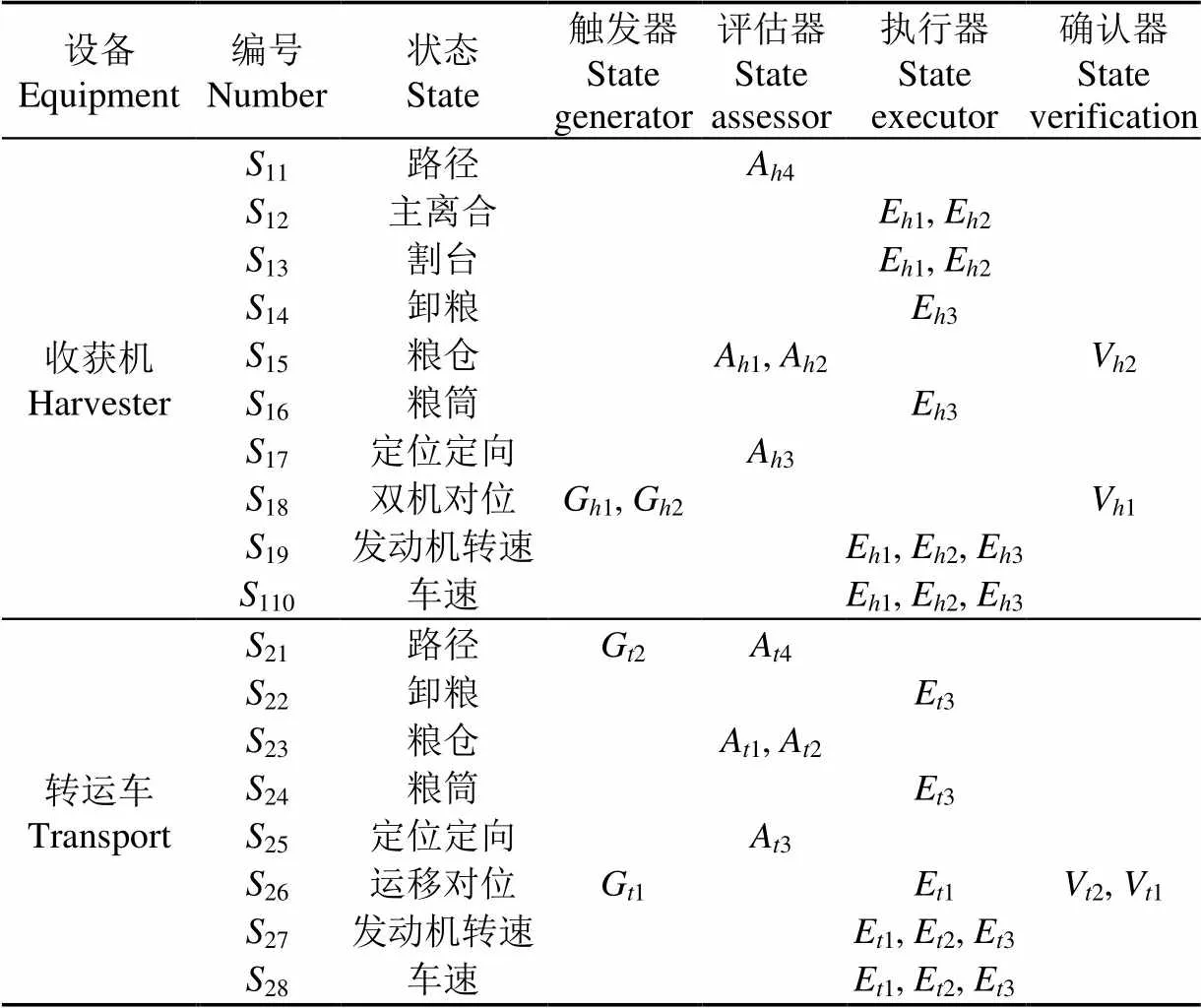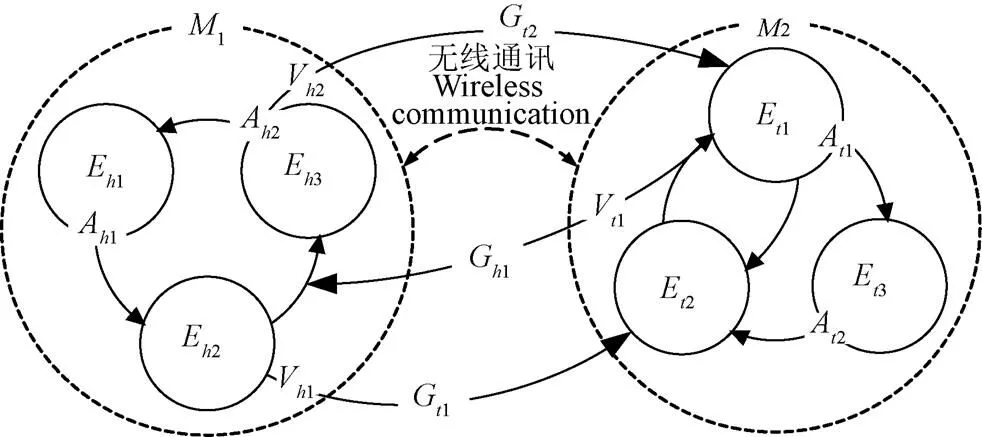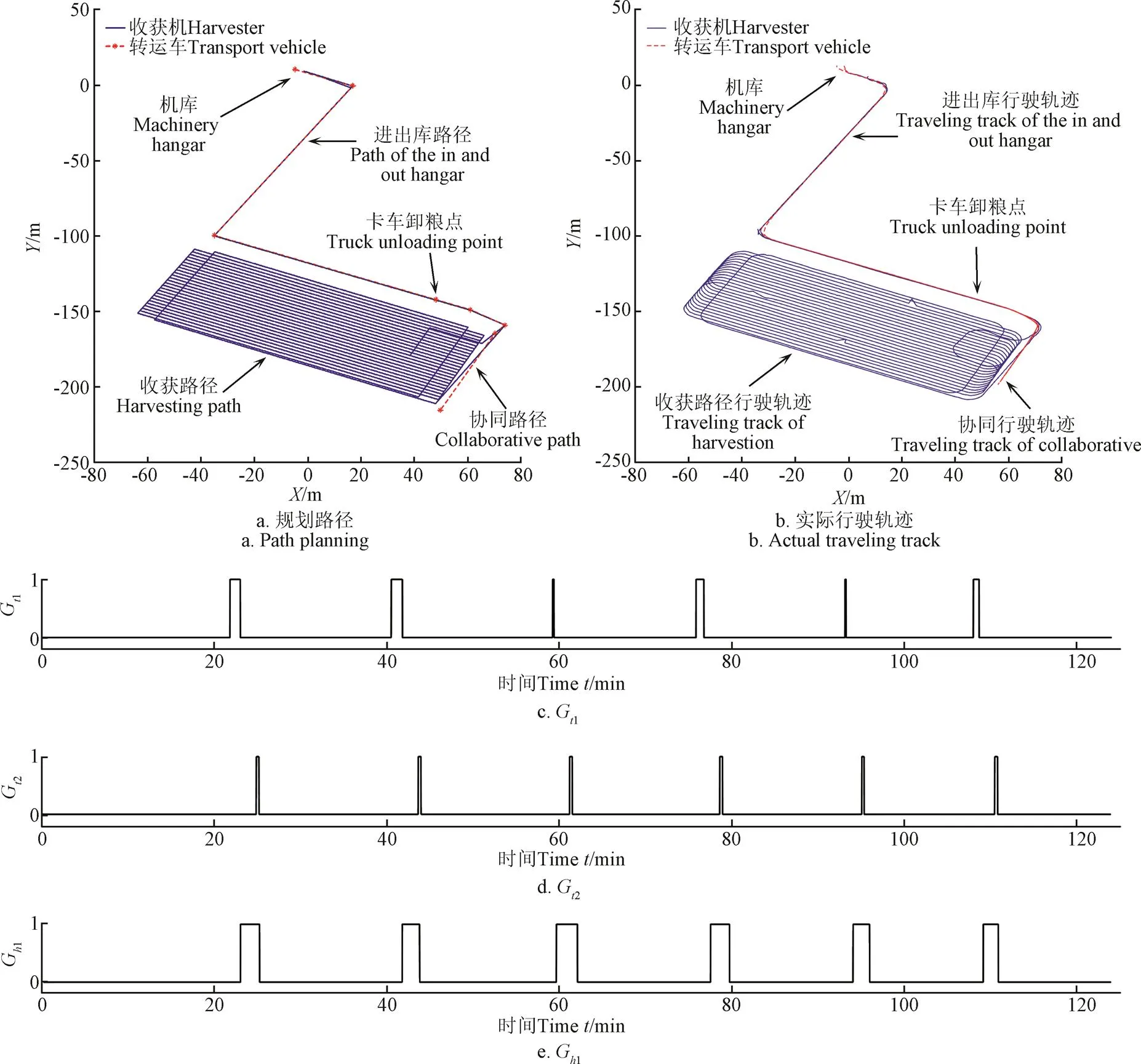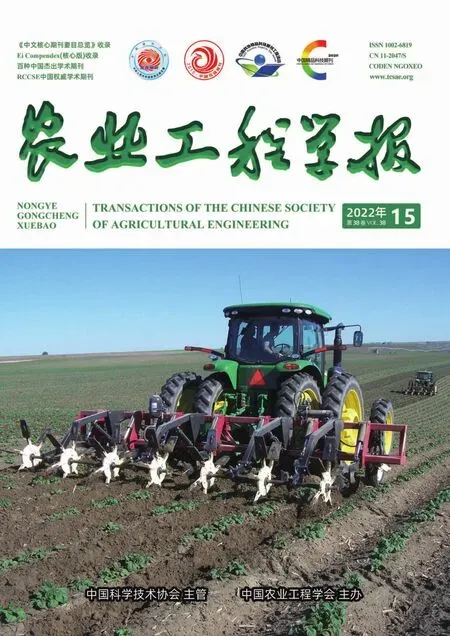水稻收獲轉運雙機協同自主作業策略與試驗
張聞宇,張智剛,張 帆,丁 凡,胡 煉,羅錫文
·農業裝備工程與機械化·
水稻收獲轉運雙機協同自主作業策略與試驗
張聞宇1,2,3,張智剛1,2,3,張 帆1,3,丁 凡1,3,胡 煉1,2,3,羅錫文1,2,3※
(1. 華南農業大學南方農業機械與裝備關鍵技術教育部重點實驗室,廣州 510642;2. 嶺南現代農業科學與技術廣東省實驗室,廣州 510642;3. 廣東省農業人工智能重點實驗室,廣州 510642)
針對水稻收獲機與轉運車雙機協同自主作業環節多、糧食轉運過程復雜等問題,該研究設計了一種基于有限狀態機(Finite State Machine,FSM)的水稻收獲機與轉運車協同作業策略,分析了水稻收獲機與轉運車協同作業模式,建立有限狀態機模型。首先,基于作業環節設計觸發條件、評估方法和執行流程等基礎模塊;然后,根據雙機協同的各項狀態建立狀態信息矩陣;最后,依據協同觸發事件與狀態轉移的邏輯設計狀態轉移鏈。構建協同作業時分復用控制邏輯框架,并運用Stateflow軟件進行仿真分析,為驗證所設計策略的田間實際作業效果,搭建了履帶式水稻收獲轉運雙機協同試驗系統,收獲速度為0.8 m/s,收割幅寬1.9 m,共28條收獲邊,協同路徑選擇在短邊的機耕道上,連續協同工作時間大于等于120 min,采用套圈路徑自主收獲0.7 hm2水稻,期間共進行6次自動協同轉運作業,將所收獲的糧食轉運到卡車上。試驗結果表明,該策略可以實現水稻收獲/卸糧轉運自主作業,收獲效率為0.35 hm2/h,為實現水稻收獲雙機智能轉運協同功能奠定了基礎,可為水稻無人農場建設提供技術支持。
農業機械;水稻;收獲;無人農場;轉運;雙機協同策略
0 引 言
水稻是主要糧食作物,保證水稻高產穩產保障國家糧食安全有重要意義。智能化機械生產能夠減輕農業勞動強度、提高生產效率和質量[1-2]。水稻智能化收獲作業復雜程度相對較高,涉及到定位測姿、路徑跟蹤、收獲控制和協同轉運等多個部分[3-5]。路徑規劃[6-7]和路徑跟蹤[8]是智能農機共性技術,國內外學者對農機直線跟蹤進行了一系列研究,包括自適應純追蹤路徑跟蹤方法[9-11]、模糊控制方法[12]、復合循環魯棒控制[13]、防側翻適應控制算法[14]、虛擬阿克曼轉向模型跟蹤算法[15]和預瞄追蹤模型算法[16],跟蹤精度可達2.5 cm。
水稻收獲時,由于收獲機糧倉容量有限,收獲機糧倉快滿時需開至田邊卸糧,影響了收獲機自動作業效率。因此,研究水稻收獲機與轉運車的協同作業系統,采用智能轉運車轉運糧食可以有效提高收獲機的作業效率。
國內外研究者對農機協同作業進行了相關研究。Noguchi等[17]提出了2種典型農機協同模式,一種是主機指定給從機作業目標,一是從機跟隨主機作業。Iida等[18]研發了一農機自動跟隨系統,采用超聲波傳感器控制隨車的相對位置和偏角。白曉平等[19]提出了一種聯合收獲機群協同作業的控制方法,在1.0 m/s的速度下,車輛跟隨平均跟蹤誤差為5.93 cm。張聞宇等[20]設計了縱向相對位置位速耦合控制器,實現了從機跟隨卸糧,在1.0 m/s的速度下,收獲機與運糧車相對縱向距離控制誤差標準差為9.2 cm。王猛[21]建立了多農機協同作業靜態任務分配模型,使作業成本降低了29.48%~55.00%。
曹如月等[22]提出了基于改進A*和Bezier曲線的多機協同全局路徑規劃,有效降低了轉彎次數。宮金良等[23]提出一種復雜環境下異質農業機器人群的任務分配及全區域覆蓋策略,4個試驗機器人可以共同完成場地的覆蓋,遍歷重復率小于7%。姚竟發等[24]針對同種機型的協同進行了路徑規劃研究,以總作業時間和作業時長為綜合優化目標,進行多機無沖突協同作業路徑優化,矩形農田總作業時間和作業時長平均分別下降了2.45%、2.29%。翟志強等[25]提出一種面向主從跟隨模式的多機協同作業導航路徑規劃方法,基于方向包圍盒算法和分離軸定理建立農機安全狀態檢測模型,路徑規劃算法用時最小值為0.453 s、最大值為1.563 s、平均值為0.951 s,可為小麥、青貯收獲等主從跟隨式多機協同自主作業提供有效的全局作業路徑。上述研究集中在弱耦合的多機空間協同路徑規劃,減少了作業時間和提高了覆蓋率。多智能體協同在機器人領域也是研究的熱點之一[26-32],對農機協同作業有借鑒作用。
上述協同研究大多集中于多機協同的協同精度控制方法和路徑規劃等,而農機協同作業系統中系統邏輯框架和協同控制策略是保證系統可靠性的關鍵。雙機協同作業模式具有環節多、交互復雜等非順序性特點,本文擬根據水稻收獲雙機協同作業需求,分析協同收獲模式,建立系統有限狀態機模型,基于該模型構建時分復用系統邏輯框架,并進行協同邏輯仿真驗證和田間試驗,以驗證水稻收獲轉運雙機協同自主作業策略的可靠性和實用性。
1 水稻收獲智能轉運雙機協同模式
Noguchi等[17]將農機協同模式分為“GOTO”(定點協同)和“FOLLOW”(跟隨協同)。水稻收獲轉運雙機協同自主作業也可以按照糧食轉運過程分為2種模式,模式1為召喚轉運模式,模式2為隨車轉運模式。模式1是全程智能收獲作業的基礎,本文針對模式1多環節協同作業和控制的特點,并將模式1分為4個基本環節(Basic Elements,BE)的循環操作:
收獲機自主收獲環節1:收獲機提高發動機轉速、啟動主離合和割臺離合,跟蹤預設收獲路徑,實現自主收獲功能;
轉運車等待召喚環節2:轉運車根據規劃的路徑行駛到待協同路段,停車、等待收獲機召喚。
收獲機向轉運車卸糧環節3:收獲機到達待卸糧位,發送信號召喚轉運車,轉運車根據通訊信息實現召喚對位協同卸糧;
轉運車卸糧環節4:轉運車根據規劃的路徑駛往運糧卡車卸糧。
1、2和4為弱耦合環節,兩車保持通訊各自完成自主規劃作業任務。3為強耦合環節,收獲機和轉運車必須實現精準定位和協同作業。
針對水稻自主收獲運糧協同作業的要求,制定智能協同流程,收獲機首先根據規劃路徑出庫下田,執行1自主收獲,轉運車隨后出庫,進入2在機耕道等待召喚,收獲機基于糧倉狀態停車召喚轉運車,進入3協同卸糧,協同卸糧完成后收獲機回到1繼續收獲,轉運車行駛至田邊道路進入4,完成卸糧后返回機耕道進入2等待收獲機再次召喚。全部收獲工作結束后收獲機執行3將糧倉中的糧食卸至轉運車中,然后自動駛回機庫,轉運車完成B后回庫,最終完成智能協同作業。
2 收獲轉運雙機協同過程建模
收獲機與轉運車智能協同作業包括自主作業和協同轉運幾個環節,本文根據協同模式將各個動作分為若干子狀態,采用有限狀態機(Finite State Machine,FSM)進行建模,有限狀態機能夠有效表示系統的各個狀態和狀態間轉移關系,在商品生產和航天航空等領域廣泛應用[33-34]。
根據收獲機和轉運車2個實體將系統分為2個模塊狀態機(Module State Machine,MSM),收獲機為1,轉運車為2。
2.1 狀態機功能模塊定義
收獲轉運雙機協同模式狀態機的組成部分包括:
1)觸發器(State Generator,)。觸發器為狀態的外部觸發輸入,功能是觸發狀態轉移。1的狀態觸發器包括:轉運車對位完成信號G1,轉運車駛離信號G2。2的狀態觸發器包括收獲機就位信號G1,收獲機卸糧結束信號G2。
2)評估器(State Assessor,)。評估器用于評估是否能進入狀態。1的狀態評估包括收獲機糧倉滿評估A1,收獲機糧倉空評估A2,收獲機直線跟蹤質量評估A3,收獲機目標路徑狀態評估A4;2的狀態評估包括轉運車糧倉滿評估A1,轉運車糧倉空評估A2,轉運車直線跟蹤質量評估A3,轉運車目標路徑狀態評估A4。
3)執行器(State Executor,)。執行器為當前狀態的執行任務,1的狀態執行器包括收獲狀態執行器E1、召喚狀態執行器E2和卸糧狀態執行器E3。2的狀態執行器包括對位狀態執行器E1,等待狀態執行器E2和卸車狀態執行器E3。
4)確認器(State Verification,)。確認器用于確認當前狀態的結果,1的狀態確認器包括:收獲機卸糧點就位確認V1、收獲機卸糧完畢確認V2。2的狀態確認器包括轉運車與收獲機對位成功確認V1、轉運車與運糧卡車對位成功確認V2。
2.2 狀態信息矩陣定義
分別將收獲機1和轉運車2的觸發器、評估器、執行器和確認器各部件組成系統狀態矩陣,收獲機狀態矩陣為1、轉運車狀態矩陣為2,1包括收獲路徑和糧倉監控等信息,收獲機的狀態1表達式如下:

式中11為路徑狀態機,12為主離合狀態機,13為割臺離合狀態,14為卸糧離合狀態,15為糧倉監測狀態,16為糧筒位置狀態,17為定位定向狀態,18為雙機對位狀態,19為發動機轉速狀態,110為車速狀態,為收獲機狀態個數。
2包括轉運路徑和糧倉監控等信息,表達式如下:

式中21為路徑狀態機,22為卸糧離合狀態,23為糧倉監測狀態,24為糧筒位置狀態,S為定位定向狀態,26為運移對位狀態,27為發動機轉速狀態,28為車速狀態,為轉運車狀態個數。
上述每個狀態都涉及觸發器、評估器、執行器、確認器,集合關系式表達式為

11需要評估收獲機是否在正常直線跟蹤狀態;收獲作業時12、13、19和110按順序結合主離合和割臺離合加油門起步,停車等待時按則逆序操作。卸糧時14、15和16基于糧倉的狀態先伸出糧筒、提高油門、結合卸糧離合,停止卸糧則逆序操作,18和19進行對位過程執行和評估。轉運車除了沒有主離合和割臺離合狀態機,其他的狀態機功能與收獲機相同。收獲機和轉運車狀態集合如表1。

表1 收獲機和轉運車狀態集合表Table 1 State parameter table of harvester and transport vehicle
注:E1為收獲狀態執行器,E2為召喚轉運車狀態執行器,E3為卸糧狀態執行器,A1為收獲機糧倉滿評估器,A2為收獲機糧倉空評估器,A3為收獲機直線跟蹤質量評估器,V1為收獲機卸糧點就位確認器,V2為收獲機卸糧完畢確認器,G1為轉運車與收獲機對位完成信號,G2為轉運車駛離信號,E1為對位狀態執行器,E2為等待狀態執行器,E3為轉運車卸糧狀態執行器,A1為轉運車糧倉滿評估器,A2為轉運車糧倉空評估器,A3為轉運車直線跟蹤質量評估器,V1為運糧車與收獲機對位成功確認器,V2為轉運車與運糧卡車對位成功確認器,G1為收獲機就位信號,G2為收獲機卸糧結束信號。
Note:E1is the state executor of harvest,E2is the state executor of calling transport,E3is the state executor of grain unloading,A1is the state assessor of harvester granary full,A2is the state assessor of harvester granary empty,A3is the state assessor of harvester line tracking quality,V1is the state verification of harvester in place unloading point,V2is the state verification of harvester finished grainunloading,G1is the state generator of transportalignment with harvest,G2is the state generator of transport leaving,E1is the state executor of alignment,E2is the state executor of waiting,E3is the state executor of the transport grain unloading,A1is the state assessor of transport granary full,A2is the state assessor of transport granary empty,A3is the state assessor of transport line tracking quality,V1is the state verification of alignment transport with harvest,V2is the state verification of alignment transport with grain transporting truck,G1is the state generator of harvester in place,G2is the state generator of harvest unloading over.
2.3 基本動作執行器
根據水稻收獲轉運協同作業過程中的操作,可以分為固定的執行流程:E1、E2、E3和E1、E2、E3。
E1順序改變18、13、12、110和11的狀態,使得收獲機從停車模式進入收獲1。
E2順序改變110、18、12和13的狀態,使得收獲機從收獲模式進入召喚等待,召喚轉運車前來運糧。
E3分2組動作,E3_1開始卸糧和E3_2停止卸糧操作。
E1分2類功能,路徑跟蹤運移和協同對位。路徑跟蹤運移E1_1,沿21的規劃路徑進行路徑運移。協同對位E1_2進行對位操作,E2使車輛從運移模式進入2。由于2卸糧系統與1相同,E3的功能和動作與E3相同,分為E3_1和E3_2。
2.4 協同作業狀態轉移鏈構建
根據4個基本環節設計狀態機的狀態轉移鏈。1環節主要由執行器E1組成,2環節主要由執行器E2組成,3環節主要由執行器E2、E3和E1組成,4環節主要E3組成。1、2和4環節相對獨立,3為強耦合環節。
當收獲機1處于E1收獲狀態,A1評估如糧倉中的水稻儲量達到閾值,1則按照11的規劃在預定路徑點上進入E2等待狀態。同時V2確認到達指定位置,通過無線網絡發送G1信號標志位至2轉運車。如果2此時處于E2狀態則進入E1執行,如果處于E3狀態則完成卸糧后前往協同地點后經由E2轉入E1執行。2執行E1,完成后,V1確認成功后發送G1觸發1的E3卸糧執行。A2監測到如糧倉已經卸空則發送G2信號給2,接著1結束卸糧執行E1。此時2根據A2評估結果,如倉儲達到閾值則進入E3卸糧流程,否則重新進入E2繼續等待。E3依據A2判斷糧空,然后依據路徑規劃到達協同位置進入E2。
依據上述流程設計水稻自動收獲/卸糧轉運雙機協同的狀態轉移鏈,如圖1所示。

注:M1為收獲機狀態機,M2為轉運機狀態機。
3 水稻自動收獲/卸糧轉運雙機協同作業邏輯
3.1 邏輯框架設計
基于上文的雙機協同模型、狀態參數和狀態轉移鏈分別設計收獲機和轉運車的邏輯框架。
雙機協同轉運邏輯框架是雙機協同模式從理論模型到技術實現的橋梁,其將路徑跟蹤控制系統、縱向對位控制算法、作業動作流程控制模塊和自動卸糧模塊等具體的技術細節進行有效整合,使得收獲運糧系統能夠在自主控制條件下完成水稻收獲轉運作業。
嵌入式導航駕駛控制器中同時有多個不同任務在運行,所以設計協同邏輯框架時采用時分復用模式,以主循環重復檢索的方式為協同框架,收獲機協同邏輯流程如圖2a所示,轉運車協同邏輯流程如圖2b所示,該流程是由雙機通訊所驅動的狀態轉移鏈流程,2組邏輯通過觸發信號相互配合運行,實現水稻收獲轉運雙機協同自主作業的功能。
3.2 協同邏輯時序仿真分析
仿真分析主要研究雙機信號傳遞與協同邏輯框架的有效性,針對雙機的順序執行器進行了簡化,引入延時替換車輛內部順序執行器。采用MATLAB中的Stateflow建立仿真模型[34]。基于協同邏輯,設計收獲機和轉運車對應的Stateflow模型,分別為Harvester模塊和Transfer模塊。其中Output和Input分別代表模塊當前狀態的輸出和下一時刻的狀態輸入,中間的延時函數Delay、Delay1代表執行的步驟所用的時間。2個模塊之間通信信號包括G1、G1和G2觸發器,傳遞方向如圖3a所示,信號間的Delay2、Delay3、Delay4代表通訊延時。其中State表示農機當前狀態,其他符號與上文定義一致。State的狀態初始值都設為1,G1、G1和G2的信號初值都設為0,時序仿真結果如圖 3b 和圖3c所示,圖中收獲機和轉運車的狀態按照設計在1至4之間有序變化,如圖3b1和2進入1和2,當1進入3,2進入3,3結束后,2進入4,1重回1,2結束4回到2,進入下一個循環。如圖3c1進入3時發出G1信號召喚2,2就位后發出G1信號,卸糧結束1發出G2信號,進入下一個循環。試驗結果表明收獲轉運流程邏輯框架有效。

圖2 雙機協同邏輯流程

注:收獲機的狀態1-4分別為Eh1、Eh2、Eh3_1和Eh3_2執行狀態,轉運車的狀態1~6分別為Et1_1、Et2、Et1_2、Et3、Et3_1和Et3_2執行狀態,輸入1、輸入2分別為收獲機和轉運車的輸入狀態,輸出1、輸出2分別為收獲機和轉運車的輸出狀態。
4 水稻自動收獲/卸糧轉運雙機協同作業田間試驗
4.1 雙機協同導航試驗系統
為驗證水稻收獲轉運雙機協同自主作業策略的實際作業效果和穩定性,構建了履帶式水稻協同收獲系統。收獲協同系統包括履帶式水稻收獲機(濰柴雷沃重工RG70V4G-014)和履帶式水稻轉運車(濰柴雷沃重工RG70V4G-015),兩機均采用全電控的底盤,主要參數如表2所示,具有線控的離合、割臺、糧筒和履帶行駛系統,采用CAN(Controller Area Network)總線發送線控協議報文。雙機均安裝雙天線BDS定位系統(司南K726),定位信息獲取頻率為10 Hz,水平定位精度為±(10+1×10-6×)mm,其中為基站到移動站的距離(km)。水稻收獲協同試驗的雙機通訊采用有人云的4/5G DTU(Data Transfer unit),型號為USR-G781,雙工通訊串口透傳頻率為1 Hz,采用16位CRC(Cyclic Redundancy Check)校驗設計串口通訊協議減少通訊誤碼率。導航控制模塊與控制終端通過RS-232通訊;雙機分別安裝了導航控制終端(eAgri-800-RS)用于收獲智能控制,通過CAN總線與雙機的底盤電控單元(Electronic Control Unit,ECU)通訊。雙機協同控制系統基于c語言運用Keil uVision5開發,協同策略邏輯嵌入其中,架構形式與文中邏輯流程一致,以雙機之間通訊驅動狀態轉移。導航系統直線路徑跟蹤算法采用預瞄跟隨控制方法[16]跟蹤標準差小于5 cm,雙機對位控制算法采用位置誤差PID(Proportion Integration Differentiation)方法[20],縱向誤差小于20 cm,控制系統結構和試驗車輛如圖4所示。

表2 收獲機和轉運車主要結構參數Table 2 Main structural parameters of harvester and transport vehicle

注:CAN為控制器局域網,RTK-GNSS為全球導航衛星定位系統實時動態測量技術。
4.2 水稻自動收獲/卸糧轉運雙機協同作業試驗設計與分析
試驗設計:協同作業試驗在華南農業大學增城試驗基地進行。試驗地長120 m,寬60 m,約0.7 hm2。由于本試驗中沒有安裝糧倉位傳感器,所以策略中的倉滿、倉空采用產量預估和定時器計算確定,及時性和準確性不高,通過仿真驗證符合邏輯運行需求。由于轉運邊是固定在機耕道上,必須完成收獲一整圈才能卸糧轉運。可以通過試驗前一次長邊的水稻收獲量估算需要2圈進行轉運。實際作業中一條長邊作業大約可以收獲20%糧倉容積的糧食,所以估算收獲機快完成2圈作業時(4條長邊收獲)提前通知轉運車做好轉運準備。設計收獲機和轉運車先后從基地機庫出發自主前往田間,收獲機到田間后啟動收獲流程開始收獲,收獲速度設置為0.8 m/s。轉運車在機耕道等待,按照所設計的協同作業策略,將收獲的糧食轉運到路邊的運糧卡車中。整塊農田收獲完成之后,順序回到機庫中,圖5為協同收獲試驗現場。

圖5 增城試驗基地水稻試驗田智能收獲試驗現場
路徑設計:按照試驗計劃,設計收獲路徑和轉運路徑。收獲路徑根據田塊大小采用先收外圈再平行套圈的方式實現覆蓋,收割路徑幅寬設為1.9 m,共28條作業邊,協同路徑選擇在短邊的機耕道上。收獲作業時短邊行駛直線路徑重合,轉運車協同只需要規劃1條復用的路徑,在該條路徑上前進或倒車就可以完成全田的糧食對位轉運工作,具體轉運點由收獲機發出的坐標計算獲得,都位于該路徑上,協同路徑如圖6a所示。
試驗分析:水稻收獲試驗中,智能收獲機與轉運車按照預定的路徑完成協同作業流程,作業軌跡如圖6b,圖中的幾處軌跡異常是因為數據記錄通訊延時導致。規劃了12組套圈路徑,每2組轉運一次,按照設計共進行了6次轉運協同,圖6c、6d和6e分別是記錄的網絡通訊邏輯觸發信號G1、G2和G1按照預定邏輯先后正常觸發,協同全過程對位準確,連續協同工作時間不少于120 min,完成協同收獲作業并返回機庫。試驗表明水稻收獲雙機協同作業策略可以實現的水稻收獲/卸糧轉運自主作業,收獲效率為0.35 hm2/h,能夠為水稻智能覆蓋收獲協同作業提供支撐。

圖6 水稻收獲轉運雙機協同作業試驗結果
5 結 論
針對水稻導航收獲協同環節多、糧食需要轉運等問題,本文設計了一種水稻收獲機和轉運車智能協同作業策略,將具體的技術進行了路徑跟蹤算法、協同對位算法、定位信息融合、通訊鏈路、底盤線控等技術按照策略有機組合,最終實現水稻收獲機和轉運車的智能化作業,具體論證如下。
1)建立了協同環節的有限狀態機模型,構建了觸發器、評估器、執行器和確認器模塊,建立了收獲轉運環節的狀態參數,定義了狀態信息矩陣以表示各項狀態的具體內容,結合該矩陣和基礎模塊設計了狀態轉移鏈,編制了協同邏輯框架。采用Stateflow仿真軟件對協同邏輯框架進行了仿真驗證。
2)構建了履帶式水稻協同收獲系統,制定了雙機通訊協議,設計了水稻收獲雙機協同試驗,包括作業流程和作業路徑。進行田間水稻收獲試驗,收獲速度為0.8 m/s,收割幅寬1.9 m,共28條收獲邊,協同路徑選擇在短邊的機耕道上,連續協同工作時間大于等于120 min,采用套圈路徑自主收獲0.7 hm2水稻,期間進行了6次自動協同轉運作業,將所收獲的糧食轉運到卡車上,試驗結果表明,可以實現的水稻收獲/卸糧轉運自主作業,收獲效率為0.35 hm2/h,狀態信號正常,能夠為水稻收獲協同作業提供支撐。
由于現有系統中未安裝糧倉傳感器,所以策略中的倉滿、倉空采用產量預估和定時器進行替換,及時性和準確性不高,未能實現策略中的所設計的全部功能。后期加入糧倉監測系統后可更好地實現收獲策略。未來的研究可以將根據收獲實際情況設計動態路徑規劃方法和融入隨車轉運模式2,將進2種模式相結合形成混合轉運模式。基于糧倉傳感器和已作業區域數據選擇執行機耕道轉運還是隨車協同轉運。當需要轉運糧食時判斷是否有可協同的安全空間可以使用,如果沒有足夠的空間,自動設置在機耕道定點轉運。經過幾圈收獲作業后將隨車轉運空間騰出后,即可指定隨車轉運模式,提高效率的同時確保可行性。
[1] 羅錫文,廖娟,胡煉,等. 我國智能農機的研究進展與無人農場的實踐 [J]. 華南農業大學學報,2021,42(6):8-17.
Luo Xiwen, Liao Juan, Hu Lian, et al. Research progress of intelligent agricultural machinery and practice of unmanned farm in China[J]. Journal of South China Agricultural University, 2021, 42(6): 8-17. (in English with Chinese abstract)
[2] 趙春江. 智慧農業的發展現狀與未來展望[J]. 華南農業大學學報,2021,42(6):1-7.
Zhao Chunjiang. Current situations and prospects of smart agriculture[J]. Journal of South China Agricultural University, 2021, 42(6): 1-7. (in Chinese with English abstract)
[3] Aravind K R, Raja P, Manuel Pérez-Ruiz. Task-based agricultural mobile robots in arable farming: A review[J]. Spanish Journal of Agricultural Research, 2017, 15(1): 1-16.
[4] Han Shufeng, He Yong, Fang Hui. Recent development in automatic guidance and autonomous vehicle for agriculture: A review[J]. Journal of Zhejiang University(Agriculture and Life Sciences), 2018, 44(4): 381-391, 515.
韓樹豐,何勇,方慧. 農機自動導航及無人駕駛車輛的發展綜述[J]. 浙江大學學報(農業與生命科學版),2018,44(4):381-391,515. (in English with Chinese abstract)
[5] 蘭玉彬,趙德楠,張彥斐,等. 生態無人農場模式探索及發展展望[J]. 農業工程學報,2021,37(9):312-327.
Lan Yubin, Zhao Denan, Zhang Yanfei, et al. Exploration and development prospect of eco-unmanned farm modes[J]. Transactions of the Chinese Society of Agricultural Engineering (Transactions of the CSAE), 2021, 37(9): 312-327. (in English with Chinese abstract)
[6] 周俊,何永強. 農業機械導航路徑規劃研究進展[J]. 農業機械學報,2021,52(9):1-14.
Zhou Jun, He Yongqiang. Research progress on navigation path planning of agricultural machinery[J]. Transactions of the Chinese Society for Agricultural Machinery, 2021, 52(9): 1-14. (in Chinese with English abstract)
[7] 黃小毛,張壘,王紹帥,等. 凸多邊形田塊下油菜聯合直播機組作業路徑規劃[J]. 農業機械學報,2022,53(1):33-40,150.
Huang Xiaomao, Zhang Lei, Wang Shaoshuai, et al. Path planning of rapeseed combine seeder in field of convex boundary[J]. Transactions of the Chinese Society for Agricultural Machinery, 2022, 53(1): 33-40, 150. (in Chinese with English abstract)
[8] 張漫,季宇寒,李世超,等. 農業機械導航技術研究進展[J]. 農業機械學報,2020,51(4):1-18.
Zhang Man, Ji Yuhan, Li Shichao, et al. Research progress of agricultural machinery navigation technology[J]. Transactions of the Chinese Society for Agricultural Machinery, 2020, 51(4): 1-18. (in Chinese with English abstract)
[9] 張朝宇,董萬靜,熊子慶,等. 履帶式油菜播種機模糊自適應純追蹤控制器設計與試驗[J]. 農業機械學報,2021,52(12):105-114.
Zhang Chaoyu, Dong Wanjing, Xiong Ziqing, et al. Design and experiment of fuzzy adaptive pure pursuit control of crawler-type rape seeder[J]. Transactions of the Chinese Society for Agricultural Machinery, 2021, 52(10): 105-114. (in Chinese with English abstract)
[10] 張智剛,羅錫文,趙祚喜,等. 基于Kalman濾波和純追蹤模型的農業機械導航控制[J]. 農業機械學報,2009,40(S):6-12.
Zhang Zhigang, Luo Xiwen, Zhao Zouxi, et al. Trajectory tracking control method based on kalman filter and pure pursuit model for agricultural vehicle[J]. Transactions of the Chinese Society of Agricultural Engineering, 2009, 40(S): 6-12. (in Chinese with English abstract)
[11] 張聞宇,丁幼春,廖慶喜,等. 基于SVR逆向模型的拖拉機導航純追蹤控制方法[J]. 農業機械學報,2016,47(1):29-36.
Zhang Wenyu, Ding Youchun, Liao Qingxi, et al. Pure pursuit control method based on SVR inverse-model for tractor navigation[J]. Transactions of the Chinese Society for Agricultural Machinery, 2016, 47(1): 29-36. (in Chinese with English abstract)
[12] Gxa B, Mc A, Xh C, et al. Path following control of tractor with an electro-hydraulic coupling steering system: Layered multi-loop robust control architecture[J]. Biosystems Engineering, 2021, 209: 282-299.
[13] Hsiao Y C, Farzaneh K, Stavros G. V, et al. Developing and evaluating an autonomous agricultural all-terrain vehicle for field experimental rollover simulations[J]. Computers and Electronics in Agriculture, 2022, 194, 106735.
[14] Zhang L H, Zhang R R, Li L L, et al. Research on virtual Ackerman steering model based navigation system for tracked vehicles[J]. Computers and Electronics in Agriculture, 2022, 192, 106615.
[15] Aravind K R, Raja P, Manuel Pérez-Ruiz. Task-based agricultural mobile robots in arable farming: A review[J]. Spanish Journal of Agricultural Research, 2017, 15(1): 1-16.
[16] 王輝,王桂民,羅錫文,等. 基于預瞄追蹤模型的農機導航路徑跟蹤控制方法[J]. 農業工程學報,2019,35(4):11-19.
Wang Hui, Wang Guimin, Luo Xiwen, et al. Path tracking control method of agricultural machine navigation based on aiming pursuit model[J]. Transactions of the Chinese Society of Agricultural Engineering (Transactions of the CSAE), 2019, 35(4): 11-19. (in Chinese with English abstract)
[17] Noguchi N, Will J, Reid J, et al. Development of a master- slave robot system for farm operations[J]. Computers & Electronics in Agriculture, 2004, 44(1): 1-19.
[18] Iida M, Kudou M, Ono K, et al. Automatic following control for agricultural vehicle[C]. Istanbul, Turkey, 6th International Workshop on Advanced Motion Control. Proceedings, 2000, 8494: 158-162.
[19] 白曉平,王卓,胡靜濤,等. 基于領航-跟隨結構的聯合收獲機群協同導航控制方法[J]. 農業機械學報,2017,48(7):14-21.
Bai Xiaoping, Wang Zhuo, Hu Jingtao, et al. Harvester group corporative navigation method based on leader-follower structure[J]. Transactions of the Chinese Society for Agricultural Machinery, 2017, 48(7): 14-21. (in Chinese with English abstract)
[20] 張聞宇,張智剛,羅錫文,等. 收獲機與運糧車縱向相對位置位速耦合協同控制方法與試驗[J]. 農業工程學報,2021,37(9):1-11.
Zhang Wenyu, Zhang Zhigang, Luo Xiwen, et al. Position-velocity coupling control method and experiments for longitudinal relative position of harvester and grain truck[J]. Transactions of the Chinese Society of Agricultural Engineering (Transactions of the CSAE), 2021, 37(9): 1-11. (in Chinese with English abstract)
[21] 王猛. 農機多機協同作業任務分配關鍵技術研究[D]. 北京:中國農業機械化科學研究院,2021.
Wang Meng. Research on Key Technologies on Farm Task Allocation for Multi-Machine Cooperative Operation[D]. Bei jing: Chinese Academy of Agricultural Mechanization Sciences, 2021. (in Chinese with English abstract)
[22] 曹如月,張振乾,李世超,等. 基于改進A*算法和Bezier曲線的多機協同全局路徑規劃[J]. 農業機械學報,2021,52(S):548-554.
Cao Ruyue, Zhang Zhenqian, Li Shichao, et al. Multi-machine cooperation global path planning based on A-star algorithm and bezier curve[J]. Transactions of the Chinese Society for Agricultural Machinery, 2021, 52(S): 548-554. (in Chinese with English abstract)
[23] 宮金良,王偉,張彥斐,等. 基于農田環境的農業機器人群協同作業策略[J]. 農業工程學報,2021,37(2):11-19.
Gong Jinliang, Wang Wei, Zhang Yanfei, et al. Cooperative working strategy for agricultural robot groups based on farmland environment[J]. Transactions of the Chinese Society of Agricultural Engineering (Transactions of the CSAE), 2021, 37(2): 11-19. (in Chinese with English abstract)
[24] 姚竟發,滕桂法,霍利民,等. 聯合收割機多機協同作業路徑優化[J]. 農業工程學報,2019,35(17):12-18.
Yao Jingfa, Teng Guifa, Huo Limin, et al. Optimization of cooperative operation path for multiple combine harvesters without conflict[J]. Transactions of the Chinese Society of Agricultural Engineering (Transactions of the CSAE), 2019, 35(17): 12 -18. (in Chinese with English abstract)
[25] 翟志強,王秀倩,王亮,等. 面向主從跟隨協同作業的導航路徑規劃方法[J]. 農業機械學報,2021,52(S):542-547.
Zhai Zhiqiang, Wang Xiuqian, Wang Liang, et al. Collaborative path planning for autonomous agricultural machinery of master-slave cooperation[J]. Transactions of the Chinese Society for Agricultural Machinery, 2021, 52(S): 542-547. (in Chinese with English abstract)
[26] Jin Y, Wei SQ, Yuan J, et al. Hierarchical and stable multiagent reinforcement learning for cooperative navigation control[J]. IEEE Transactions on Neural Networks and Learning Systems( Early Access ), 2021, 9(19): 1-14.
[27] Gxa B, Mc A, Xh C, et al. Path following control of tractor with an electro-hydraulic coupling steering system: Layered multi-loop robust control architecture[J]. Biosystems Engineering, 2021, 209: 282-299.
[28] Valery P, Lyudmila V, Inna N, et al. The problem of choice of optimal technological decisions on harvester control[J]. MATEC Web of Conferences, 2018, 226: 1-6
[29] Wang H L, Yao Z X, Guo Y H. Collaborative control of unmanned underwater vehicles[J]. Journal of Physics: Conference Series, 2021, 1887(1): 1-5.
[30] 朱良麒,丁力平,陳文亮,等.-Shape算法雙機器人協作工作空間研究[J]. 機械設計與制造雜志社,2021(10):267-271,278.
Zhu Liangqi, Ding Liping, Chen Wenliang, et al. The study of dual-robot cooperative workspace based on α-shape 3d reconstruction theory[J]. Machinery Design & Manufacture, 2021(10): 267-271, 278. (in Chinese with English abstract)
[31] 牛作碩,宮金良,張彥斐. 基于多路線追蹤的機器人局部路徑規劃與實驗[J]. 計算機應用與軟件,2022,39(1):60-64.
Niu Zuoshuo, Gong Jinliang, Zhang Yanfei. Robot local path planning and experriment based on multi-path tracking[J]. Computer Application and Software, 2022, 39(1): 60-64. (in Chinese with English abstract)
[32] Liu L Y, Liu Q Y, Song Y, et al. A collaborative control method of dual-arm robots based on deep reinforcement learning[J]. Applied Sciences, 2021, 11(4): 1-16.
[33] 孫鵬,譚玉璽,湯磊. 基于有限狀態機的作戰實體模型行為規則可視化建模[J]. 指揮控制與仿真,2015,37(2):27-30.
Sun Peng, Tan Yuxi, Tang Lei. Visual modeling of combat entities behavior model rules based on finite state machine[J]. Command Control & Simulation, 2015, 37(2): 27-30. (in Chinese with English abstract)
[34] 聞霞,任雯,賴森財,等. 基于有限狀態機模型的全自動燙印機控制系統設計[J]. 工程設計學報,2020,27(6):771-780.
Wen Xia, Ren Wen, Lai Sencai, et al. Design of control system of automatic hot stamping machine based on finite state machine model[J]. Chinese Journal of Engineering Design, 2020, 27(6): 771-780. (in Chinese with English abstract)
Cooperative autonomous operation strategy and experiment of the rice harvester together with a rice-transporting vehicle
Zhang Wenyu1,2,3, Zhang Zhigang1,2,3, Zhang Fan1,3, Ding Fan1,3, Hu Lian1,2,3, Luo Xiwen1,2,3※
(1.,,,510642,; 2.,510642,; 3(),510642,)
Many links and complex cooperative operations have posed a great challenge to the autonomous harvesting between rice harvester and transfer vehicle. In this study, a cooperative operation strategy was designed for the autonomous rice harvester and transfer vehicle using Finite State Machine (FSM). The cooperative mode was then divided into four links: independent harvesting, waiting for calls, cooperative truck unloading grain, and transportation. An FSM model was also established to construct the basic components of a collaborative harvesting state machine. After that, the state information matrix was defined to design the specific flow of basic action execution, including the harvester starts harvesting, stops harvesting, starts unloading grain and stops unloading grain. The transfer vehicle was then driven at the waiting point to cooperate with the alignment, then to start or stop grain unloading. As such, the state transition chain of collaborative work was constructed to clarify the transition relationship and trigger conditions between the states in the process of collaboration. The cooperative control logic framework involved the harvester and transfer vehicle, according to the state transition chain architecture. Stateflow tool was selected to simulate and verify the compiled logic framework in the MATLAB platform. The sequential execution was also simplified to introduce the timing and signal transmission delay of internal execution. The simulation results show that the states of the harvester and transfer vehicles were transferred orderly, particularly with the correct conversion of the trigger signal. The test results also show that the control logic strategy performed better for cooperative harvesting. A crawler-type rice collaborative harvesting system was constructed to verify the actual operating performance of the logic strategy, including the crawler rice harvester (Weichai Lovol Heavy Industry RG70V4G-014) and crawler rice transfer vehicle (Weichai Lovol Heavy Industry RG70V4G-015). Among them, the two intelligent agricultural machines adopted the fully electronically controlled chassis with the wire-controlled clutch, header, grain cylinder, and crawler driving system. The dual antenna BDS positioning system (Sina K726) was also equipped, where the data transfer unit (USR-G781) was used in the communication between two computers in the fixed-point cooperative experiment of rice harvesting. The 4/5 G Data Transfer Unit (DTU) with human cloud was adopted at the same time. The autonomous control module was communicated with the control terminal through RS-232. A Self-control terminal (eAgri-800-RS) was installed in the two computers for the harvesting self-control, which communicated with the chassis Electronic Control Unit of the two computers through CAN bus. The software system was developed by Keil uVision 5. The linear path tracking was adopted to follow the model control in the navigation system. The two-computer alignment control was adopted to deal with the position error PID. The collaborative system test was carried out in the Zengcheng Experimental Base of South China Agricultural University. The harvester and transfer vehicle were designed to independently work in the field from the hangar of the base. Specifically, the harvesting speed and width were set at 0.8 m/s, and 1.9 m, respectively. The continuous cooperative working time was not less than 120 min. About 0.7 hm2of rice were automatically harvested by the ferrule path. Six operations of the automatic cooperative transfer system were carried out to transfer the grain to the truck during this period. The transfer truck waited on the tractor road, and then transferred the harvested grain to the roadside truck, according to the designed fixed-point cooperative operation strategy. The harvester and transfer vehicle returned to the hangar in sequence after harvesting the whole farmland. The harvest and transportation path were also designed in the test plan. Among them, the specific harvesting path was designed to cover the field, where the outer ring was harvested first and then parallel rings, according to the size of the field. The cooperative path was selected on the short-side tractor road. A balance was obtained on the short-side straight-line paths of the harvesting operation. The transfer vehicles only needed to plan a reusable path. The grain alignment transfer work was completed to advance or reverse this path in the whole field. The specific transfer points were calculated from the coordinates issued by the harvester, all of which were located on this path. Consequently, the fixed-point cooperative operation was also realized using the autonomous harvester and the transfer vehicle, according to the predetermined path. The logic signals were successively recorded to normally trigger during network communication under the predetermined logic framework in the test. The whole cooperative process was aligned accurately to successfully complete the fixed-point cooperative harvesting operation and return to the hangar. Therefore, the cooperative operation strategy of double machines for rice harvesting was effective and reliable under the configuration, and the harvesting efficiency was 0.35 hm2/h. The finding can also provide strong support for the cooperative operation of autonomous full coverage harvesting in rectangular rice regions.
agricultural machinery; rice; harvesting; unmanned farm; transport; cooperation strategy between harvester and transfer vehicle
10.11975/j.issn.1002-6819.2022.15.001
S147.2
A
1002-6819(2022)-15-0001-09
張聞宇,張智剛,張帆,等. 水稻收獲轉運雙機協同自主作業策略與試驗[J]. 農業工程學報,2022,38(15):1-9.doi:10.11975/j.issn.1002-6819.2022.15.001 http://www.tcsae.org
Zhang Wenyu, Zhang Zhigang, Zhang Fan, et al. Cooperative autonomous operation strategy and experiment of the rice harvester together with a rice-transporting vehicle[J]. Transactions of the Chinese Society of Agricultural Engineering (Transactions of the CSAE), 2022, 38(15): 1-9. (in Chinese with English abstract) doi:10.11975/j.issn.1002-6819.2022.15.001 http://www.tcsae.org
2022-03-30
2022-06-06
國家重點研發計劃項目(2021YFD2000602);智慧農場技術與裝備集成應用模式與數字化展示(2130106);廣東省基礎與應用基礎研究基金項目(2019A1515111152)
張聞宇,博士,講師,研究方向為精準農業、無人農場關鍵技術、農業機械智能控制。Email:zhangwenyu@scau.edu.cn
羅錫文,教授,中國工程院院士,研究方向為農業機械化、電氣化和自動化。Email:xwluo@scau.edu.cn

